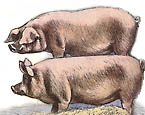|
Wild
Boar (Domestic Pig)
(Sus scrofa domesticus) #61-361 |
||||
|
|
Physical
characteristics and distribution
|
|
The Domestic Pig (Sus scrofa domesticus) is usually given the scientific name Sus scrofa, though some authors call it S. domesticus, reserving S. scrofa for the Wild boar. It was domesticated approximately 5,000 to 7,000 years ago. Their coats are coarse and bristly. They are born brownish colored and tend to turn more grayish colored with age. The upper canines form sharp distinctive tusks that curve outward and upward. Compared to other artiodactyles, their head is relatively long, pointed, and free of warts. Their head and body length ranges from 900-1,800 mm and can weigh 50-350 kg. The Wild Boar inhabited scrubs and forests, including arid environments. They can easily adapt to different habitats due to the scarcity of food. Sus scrofas domesticus feed on fungi, tubers, green vegetation, grains, nuts, cultivated crops, invertebrates, small vertebrates, and carrion. Except for old boars who are solitary, they live in groups of 20-30 individuals on average. In addition, they are nocturnal and crepuscular animals that travel far each night searching for food. Whenever available, they will wallow in the mud for hours at a time. Breeding occurs throughout the year in the tropics, but births peak around rainy seasons. The solitary adult males together and fight for the right to mate with a female. A single male usually wins control over 4 females on average. The number of young per liter ranges from 1-12. After the young are weaned, two or more families may come together until the next mating season. Dmestic Pigs are found across Europe, the Middle East and extend into Asia as far as Indonesia and Japan. They were brought to southeastern North America from Europe by De Soto and other early Spanish explorers. |
|
Description
of the brain
|
|
Animal
source and preparation
|
|
All
specimens collected followed the same preparation
and histological procedure.
|
Other Related Resources (websites and publications)
List of Specimens | Explore Collections | Brain Sections | Brain Evolution | Brain Development | Brain Circuitry | Brain Functions | Location and Use | Related Web Sites | Contact Us | Search MSU Database | Personnel | Home


